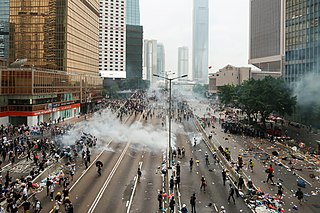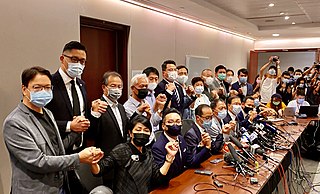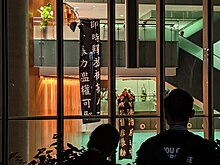
Leung Kwok-hung, also known by his nickname "Long Hair" (長毛), is a Hong Kong politician and social activist. He was a member of the Legislative Council, representing the New Territories East. A Trotskyist in his youth, he was a founding member of the Revolutionary Marxist League. He became a political icon with his long hair and Che Guevara T-shirt in the protests before he was elected to the Legislative Council in 2004. In 2006, he co-founded a social democratic party, the League of Social Democrats (LSD) of which he was the chairman from 2012 to 2016.

The Hong Kong 1 July protests was an annual protest rally originally held by the Civil Human Rights Front from the day of handover in 1997 on the HKSAR establishment day. However, it was not until 2003 that the march drew large public attention by opposing the legislation of Basic Law Article 23. The 2003 protest, with 500,000 marchers, was the second-largest protest seen in Hong Kong since the 1997 handover.

The New Year marches were a fixture on the political calendar in Hong Kong. Thousands took to the streets demanding universal suffrage as part of the ongoing democratic development as well as to protest against further influence of mainland China in Hong Kong. Lead organiser for marches was the Civil Human Rights Front (CHRF). The Front disbanded in August 2021, following accusations by police in April that it was suspected of operating illegally due to not having been registered as organisation; its last remaining spokesperson Figo Chan had been jailed in May in relation to the 2019–2020 Hong Kong protests.

The administration of Leung Chun-ying as Chief Executive of Hong Kong, officially referred to as "The 4th term Chief Executive of Hong Kong" relates to the period of governance of Hong Kong since the transfer of sovereignty over Hong Kong, between 1 July 2012 and 30 June 2017.
Abdull Ghafar Khan, better known as Phillip Khan, is a Hong Kong businessman and political activist. A Pakistani national born and raised in Hong Kong, Khan's ambitions to stand for election to the city's Legislative Council reportedly have been blocked by the refusal of the Hong Kong Immigration Department to consider his application for naturalisation as a Chinese national.

The Legislative Council Complex is the headquarters of the Legislative Council of Hong Kong. The complex plays a central role in the legislative process of the Hong Kong Special Administrative Region (SAR), and it has been a focal point for political events and public demonstrations.

Ted Hui Chi-fung is a Hong Kong politician. He formerly represented the Chung Wan constituency in the Central and Western District Council, and formerly he was the Legislative Councillor for the Hong Kong Island constituency. Fearing prosecution by the Government of Hong Kong, he announced his self-exile in Denmark and withdrawal from the Democratic Party in December 2020.

The Sixth Legislative Council of Hong Kong was the sixth meeting of the legislative branch of the Hong Kong Special Administrative Region Government. Running from 1 October 2016 to 31 December 2021, it was the longest legislative session in Hong Kong history, lasted for five years and three months. The term of the session was originally from 1 October 2016 to 30 September 2020, but was extended by the National People's Congress Standing Committee (NPCSC) due to the postponement of the 2020 Legislative Council election.
The Hong Kong Legislative Council members' oath-taking controversy was a series of events surrounding the oaths of office of a dozen pro-democracy and localist camp members-elect of the Legislative Council of Hong Kong (LegCo) on 12 October 2016 which have resulted in the disqualification of six members, Sixtus "Baggio" Leung and Yau Wai-ching of Youngspiration, who were unseated by the court on 15 November 2016, and Leung Kwok-hung, Nathan Law, Yiu Chung-yim and Lau Siu-lai on 14 July 2017.

The 2019 Hong Kong District Council elections were held on 24 November 2019 for all 18 District Councils of Hong Kong. 452 seats from all directly elected constituencies, out of the 479 seats in total, were contested. Nearly three million people voted, equivalent to 71 per cent of registered voters, an unprecedented turnout in the electoral history of Hong Kong. The election was widely viewed as a de facto referendum on the concurrent anti-extradition protests.

The Fugitive Offenders and Mutual Legal Assistance in Criminal Matters Legislation (Amendment) Bill 2019 was a proposed bill regarding extradition to amend the Fugitive Offenders Ordinance in relation to special surrender arrangements and the Mutual Legal Assistance in Criminal Matters Ordinance so that arrangements for mutual legal assistance can be made between Hong Kong and any place outside Hong Kong. The bill was proposed by the Hong Kong government in February 2019 to establish a mechanism for transfers of fugitives not only for Taiwan, but also for Mainland China and Macau, which are currently excluded in the existing laws.

The 2019–2020 Hong Kong protests were a series of demonstrations against the Hong Kong government's introduction of a bill to amend the Fugitive Offenders Ordinance in regard to extradition. It was the largest series of demonstrations in the history of Hong Kong.

The period from March to June 2019 in the 2019–2020 Hong Kong protests is considered the early stage of the movement. Until the first mass demonstrations in June, protests were focused on the withdrawal of the extradition bill. In June, protesters started to lay out five demands. The additional four demands concerned the reactions of the Hong Kong government and especially, the police to the protests, and called more broadly for full democracy in the city.

The founding cause of the 2019–2020 Hong Kong protests was the proposed legislation of the 2019 Hong Kong extradition bill. However, other causes have been pointed out, such as demands for democratic reform, the Causeway Bay Books disappearances, or a general fear of losing a "high degree of autonomy". The Hong Kong protests are unique in this respect from democracy protests in general, which are often provoked by economic grievances. Subsequent actions by the police, such as mass arrests and police violence, as well as what was perceived to be an illegitimate legislative process of the bill, sparked additional protests throughout the city.

This segment of the timeline of the 2019–2020 Hong Kong protests covers the month of July 2019. The anniversary of the 1997 handover of Hong Kong to China on 1 July saw large daytime protests. In the evening of that day, protesters stormed the Legislative Council Building and defaced symbols, with police only moving in after midnight. This incident, which was sharply condemned by the government of Carrie Lam, did however not lead to a split between peaceful and violent protesters. Observers linked the understanding of the non-violent protesters for the violent wing to the lack of willingness of the Lam government to engage in dialogue about the protesters' five demands. Apart from major protests on Sundays, there were also mostly peaceful demonstrations during the week.

The conduct of the Hong Kong Police Force is a subject of controversy during the 2019–2020 Hong Kong protests. Tactics employed by the force have led to misconduct allegations and protesters have accused the Hong Kong government of using the police as a method to resolve a "lingering political crisis." Actions taken by the police force and the Hong Kong government have caused mixed reactions inside Hong Kong and in the general international community. Allegations against the police include excessive use of force, force against unspecific targets, and arrest without warrant. These allegations have been presented in various media both supporting and detracting from the complaints, such as through amateur video. In general, the spirit, rumors, videos, and other media shared by the public have caused a drop in support for the police force, and an Amnesty International report accused the police of using excessive force against civilians. One of the objectives of the 2019–2020 protests is establishment of an independent inquiry system into said allegations.

The 2019 Prince Edward station attack, also known as the 31 August MTR station incident, was an incident in which Hong Kong police indiscriminately attacked passengers while arresting protesters who were returning home via Prince Edward station, on the night of 31 August 2019, after a protest was held that same day. The event was described as the police version of the 2019 Yuen Long attack, and the police have been criticised as acting like terrorists. Rumours have been circulated that several protesters were beaten to death at the station, but the police have rejected allegations. However, a mourning vigil was set up by a group of residents outside one exit of the station.

The 12 June 2019 Hong Kong protest, also known as "612 incident". refers to an incident of intense confrontation between anti-extradition bill protesters and the Hong Kong Police Force, occurring on 12 June 2019 outside the Government Headquarters in Admiralty, Hong Kong Island. The protest was sparked by the government's introduction of the controversial Fugitive Offenders amendment bill, which was set to go through second reading on 12 June despite mass opposition.

The 2020 Hong Kong Legislative Council election was originally scheduled on 6 September 2020 until it was postponed by the government. On 31 July 2020, Chief Executive Carrie Lam announced that she was invoking the Emergency Regulations Ordinance to postpone the election under the emergency powers granted to her by it, citing the recent resurgence of the COVID-19 cases, adding that the move was supported by Beijing.

On 11 November 2020, 15 Hong Kong pro-democracy members of the Legislative Council announced their resignations in protest against the decision of the National People's Congress Standing Committee (NPCSC) which bars Legislative Council members from supporting Hong Kong independence, refusing to recognise Beijing's sovereignty over Hong Kong, seeking help from "foreign countries or foreign forces to interfere in the affairs of the region" or committing "other acts that endanger national security" that resulted in the disqualification of pro-democracy legislators Alvin Yeung, Dennis Kwok, Kwok Ka-ki and Kenneth Leung. In July 2020, the four had been barred from running in the subsequently postponed Legislative Council election originally scheduled for September 2020. The resignation en masse left the Legislative Council membership dwindled to 43 out of the total number of 70 seats, with virtually no opposition for the first time since the 1997 handover.




















